What Cloud Computing Technologies ? Cloud Computing
What Cloud Computing Technologies?
There’re certain technologies that are working behind the cloud computing platforms making cloud
computing flexible, reliable, usable. These technologies are listed below:
- Virtualization of Cloud Computing
- Service-Oriented Architecture (SOA) of Cloud Computing
- Grid Computing of Cloud Computing
- Utility Computing of Cloud Computing
Virtualization of Cloud Computing
Virtualization is a technique, which allows to share single physical instance of an application or resource among multiple organizations or tenants (customers). It does so by assigning a logical name to a physical resource and providing a pointer to that physical resource when demanded.
The Multitenant architecture offers virtual isolation among the multiple tenants and therefore the organizations can use and customize the application as though they each have its own instance running.
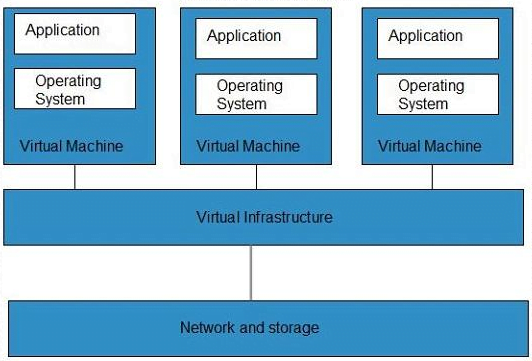
Service-Oriented Architecture(SOA) OF CLOUD COMPUTING
What Cloud Computing Technologies?
Service-Oriented Architecture helps to use applications as a service for other applications regardless the type of vendor, product or technology. Therefore, it is possible to exchange of data between applications of different vendors without additional programming or making changes to services.
Cloud Computing Service Oriented Architecture

What Cloud Computing Technologies?
Grid Computing
Grid Computing refers to distributed computing in which a group of computers from multiple locations are connected with each other to achieve common objective. These computer resources are heterogeneous and geographically dispersed.
Grid Computing breaks complex task into smaller pieces. These smaller pieces are distributed to CPUs that reside within the grid.
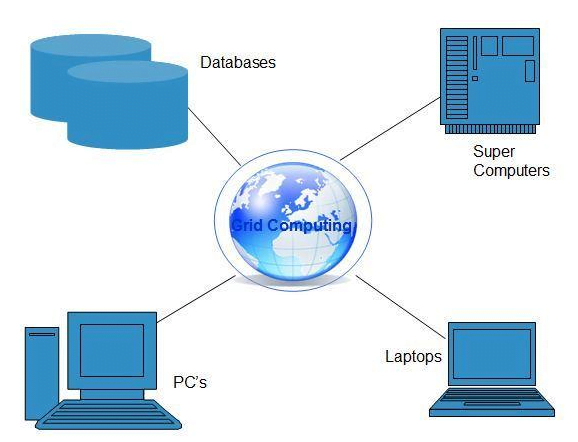
Utility Computing
What Cloud Computing Technologies?
Utility computing is based on Pay per Use model. It offers computational resources on demand as a metered service. Cloud computing, grid computing, and managed IT services are based on the concept of Utility computing.
Cloud Computing Infrastructure
Cloud Infrastructure Components Complete explanation
Cloud infrastructure consists of servers, storage, network, management software, and deployment
software and platform virtualization.

HYPERVISOR OF CLOUD COMPUTING
What Cloud Computing Technologies?
Hypervisor is a firmware or low-level program that acts as a Virtual Machine Manager. It allows to share the single physical instance of cloud resources between several tenants.
MANAGEMENT SOFTWARE OF CLOUD COMPUTING
Management Software helps to maintain and configure the infrastructure
DEPLOYMENT SOFTWARE OF CLOUD COMPUTING
Deployment software helps to deploy and integrate the application on the cloud
NETWORK IN CLOUD COMPUTING
Network is the key component of cloud infrastructure. It allows to connect cloud services over the Internet. It is also possible to deliver network as a utility over the Internet, i.e., the consumer can customize the network route and protocol. What Cloud Computing Technologies?
SERVER OF CLOUD COMPUTING
Server helps to compute the resource sharing and offer other services such as resource allocation and
deallocation, monitoring resources, security, etc.
STORAGE IN CLOUD COMPUTING
Cloud uses distributed file system for storage purpose. If one of the storage resource fails, then it can be extracted from another one which makes cloud computing more reliable.
Infrastructural Constraints in Cloud Computing | What Cloud Computing Technologies?
Fundamental constraints that cloud infrastructure should implement are shown in the following diagram:
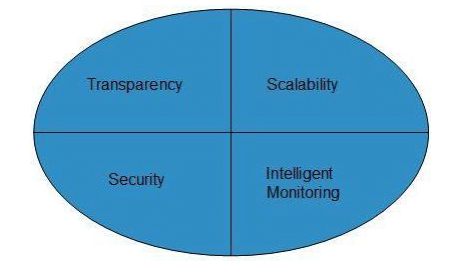
TRANSPARENCY OF CLOUD COMPUTING
Since virtualization is the key to share resources in cloud environment. But it is not possible to satisfy the demand with single resource or server. Therefore, there must be transparency in resources, load balancing and application, so that we can scale them on demand.
SCALABILITY IN CLOUD COMPUTING | What Cloud Computing Technologies?
Scaling up an application delivery solution is not that easy as scaling up an application because it involves configuration overhead or even re-architecting the network. So, application delivery solution is need to be scalable which will require the virtual infrastructure such that resource can be provisioned and de-provisioned easily. What Cloud Computing Technologies?
INTELLIGENT MONITORING IN CLOUD COMPUTING
To achieve transparency and scalability, application solution delivery will need to be capable of intelligent
monitoring.
SECURITY OF CLOUD COMPUTING
The mega data center in the cloud should be securely architected. Also the control node, a entry point in mega data center also needs to be secure.
Cloud Computing-Architecture
The Cloud Computing architecture comprises of many cloud components, each of them are loosely
coupled. We can broadly divide the cloud architecture into two parts:
- Front End Cloud Computing Architecture
- Back End Cloud Computing Architecture
Each of the ends are connected through a network, usually via Internet. The following diagram shows the graphical view of cloud computing architecture: What Cloud Computing Technologies?

FRONT END Cloud Computing Architecture
Front End refers to the client part of cloud computing system. It consists of interfaces and applications that are required to access the cloud computing platforms, e.g., Web Browser.
BACK END Cloud Computing Architecture
Back End refers to the cloud itself. It consists of all the resources required to provide cloud computing services. It comprises of huge data storage, virtual machines, security mechanism, services, deployment models, servers, etc. What Cloud Computing Technologies?
Important Points of Cloud Computing Architecture
- It is the responsibility of the back end to provide built-in security mechanism, traffic control and protocols.
- The server employs certain protocols, known as middleware, helps the connected devices to communicate with each other.
Public Cloud Model
Complete explanation of Public Cloud
The Public Cloud allows systems and services to be easily accessible to general public, e.g., Google,
Amazon, Microsoft offers cloud services via Internet. What Cloud Computing Technologies?
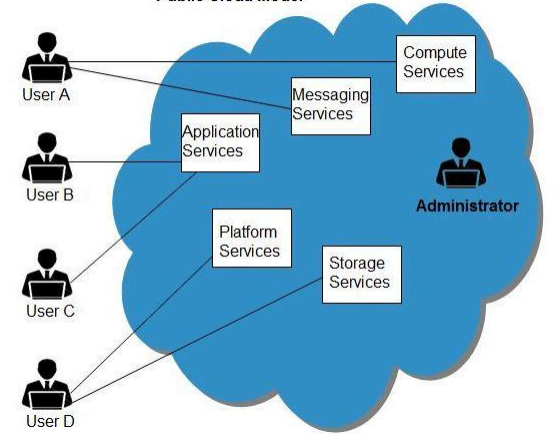
Benefits of Public Cloud Model
There are many benefits of deploying cloud as public cloud model. The following diagram shows some of those benefits:
COST EFFECTIVE OF PUBLIC CLOUD COMPUTING
Since public cloud share same resources with large number of consumer, it has low cost.
RELIABILITY OF PUBLIC CLOUD MODEL
Since public cloud employs large number of resources from different locations, if any of the resource fail, public cloud can employ another one.
FLEXIBILITY OF PUBLIC CLOUD MODEL
It is also very easy to integrate public cloud with private cloud, hence gives consumers a flexible approach. What Cloud Computing Technologies?
LOCATION INDEPENDENCE OF PUBLIC CLOUD MODEL
Since, public cloud services are delivered through Internet, therefore ensures location independence.
UTILITY STYLE COSTING IN PUBLIC CLOUD MODEL
Public cloud is also based on pay-per-use model and resources are accessible whenever consumer needs it.
HIGH SCALABILITY IN PUBLIC CLOUD MODEL
Cloud resources are made available on demand from a pool of resources, i.e., they can be scaled up or down according the requirement.
Disadvantages of Public Cloud Model
Here are the disadvantages of public cloud model:
LOW SECURITY in Public Cloud Model
In public cloud model, data is hosted off-site and resources are shared publicly, therefore does not ensure higher level of security. What Cloud Computing Technologies?
LESS CUSTOMIZABLE in Public Cloud Model
It is comparatively less customizable than private cloud.
Private Cloud Model
Full Explanation of Private Cloud
The Private Cloud allows systems and services to be accessible with in an organization. The Private Cloud is operated only within a single organization. However, It may be managed internally or by third-party. What Cloud Computing Technologies?
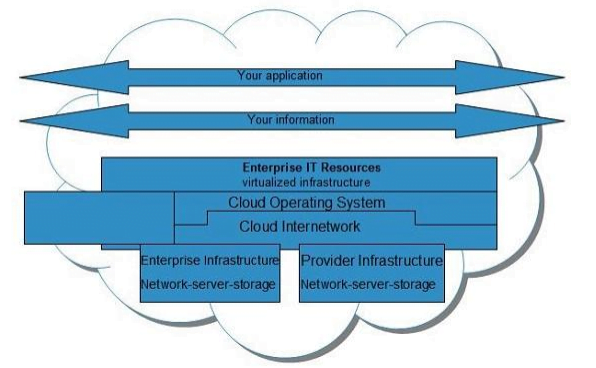
Benefits of Private Cloud
There are many benefits of deploying cloud as private cloud model. The following diagram shows some of those benefits: What Cloud Computing Technologies?
HIGHER SECURITY AND PRIVACY OF PRIVATE CLOUD
Private cloud operations are not available to general public and resources are shared from distinct pool of
resources, therefore, ensures high security and privacy.
MORE CONTROLS IN PRIVATE CLOUD
Private clouds have more control on its resources and hardware than public cloud because it is accessed only within an organization.
COST AND ENERGY EFFICIENCY OF PRIVATE CLOUD
Private cloud resources are not as cost effective as public clouds but they offer more efficiency than public cloud. What Cloud Computing Technologies?
Disadvantages of Private Cloud
Here are the disadvantages of using private cloud model:
RESTRICTED AREA
Private cloud is only accessible locally and is very difficult to deploy globally.
INFLEXIBLE PRICING
In order to fulfill demand, purchasing new hardware is very costly
LIMITED SCALABILITY
Private cloud can be scaled only within capacity of internal hosted resources.
ADDITIONAL SKILLS OF PRIVATE CLOUD
In order to maintain cloud deployment, organization requires more skilled and expertise.
Hybrid Cloud Model
Definition of Hybrid Cloud
The Hybrid Cloud is a mixture of public and private cloud. Non-critical activities are performed using public cloud while the critical activities are performed using private cloud.
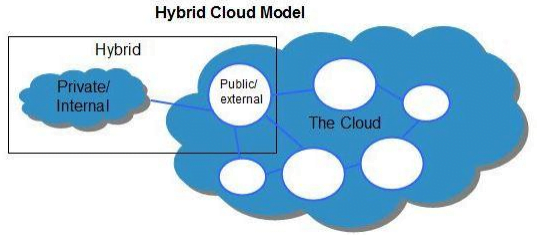
Benefits Hybrid Cloud
There are many benefits of deploying cloud as hybrid cloud model. The following diagram shows some of those benefits: What Cloud Computing Technologies?
SCALABILITY OF HYBRID CLOUD
It offers both features of public cloud scalability and private cloud scalability.
FLEXIBILITYOF HYBRID CLOUD
It offers both secure resources and scalable public resources.
COST EFFICIENCIES OF HYBRID CLOUD
Public cloud are more cost effective than private, therefore hybrid cloud can have this saving.
SECURITY OF HYBRID CLOUD
Private cloud in hybrid cloud ensures higher degree of security.
Disadvantages of Hybrid Cloud :
NETWORKING ISSUES
Networking becomes complex due to presence of private and public cloud.
SECURITY COMPLIANCE
It is necessary to ensure that cloud services are compliant with organization’s security policies.
INFRASTRUCTURAL DEPENDENCY
The hybrid cloud model is dependent on internal IT infrastructure, therefore it is necessary to ensure redundancy across data centers.
Community Cloud Model
Complete understanding of Community Cloud Model
The Community Cloud allows system and services to be accessible by group of organizations. It shares
the infrastructure between several organizations from a specific community. It may be managed internally or by the third-party.
Benefits of Community Cloud Computing Model
There are many benefits of deploying cloud as community cloud model. The following diagram shows some of those benefits:
COST EFFECTIVE OF Community Cloud Model
- Community cloud offers same advantage as that of private cloud at low cost.
- Sharing Between Organizations
- Community cloud provides an infrastructure to share cloud resources and capabilities among several organizations.
SECURITY IN Community Cloud Model
Community cloud is comparatively more secure than the public cloud.
ISSUES IN Community Cloud Model
- Since all data is housed at one location, one must be careful in storing data in community cloud because it might be accessible by others.
- It is also challenging to allocate responsibilities of governance, security and cost.
Click here to know about more Cloud Computing | Click here to know more about Cloud Computing



